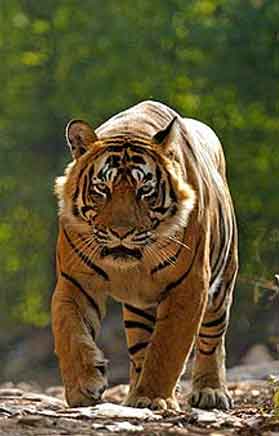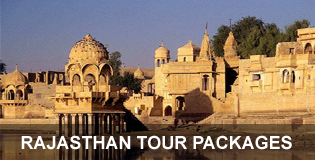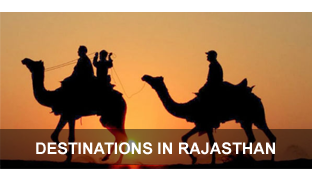Itinerary Details
Day 1 Arrive Delhi
You will be met on arrival at the Delhi airport and get transferred to the hotel. Enjoy the hospitality of the hotel in Delhi and overnight stay.
Day 2 Full day city tour of the Capital Delhi
Sightseeing of Old Delhi includes a visit to the Red Fort, built in 1648 during the reign of Shah Jehan in red sandstone, which gave the fort its name. Jama Masjid is India's largest mosque, built of red sandstone and white marble in the middle of the 17th century. Chandni Chowk (Silver Street), once the imperial avenue down which Shah Jehan rode at the head of lavish cavalcades, is today bustling with shops, stalls and silversmiths' ateliers. Also visit Raj Ghat where Mahatma Gandhi was cremated, Shakti Sthal, the cremation spot of Indira Gandhi and Veer Bhumi, memorial to Rajiv Gandhi. Sightseeing of New Delhi includes a visit to India Gate, built in memory of Indian soldiers killed during the First World War. Rashtrapati Bhawan, built in the early 20th century as the Imperial residence of the Viceroy is today the official residence of the President of India and Parliament House, an unique circular building with huge colonnades, houses the Upper and Lower Houses of Parliament. Humayun's Tomb is the first Mughal garden tomb. Visitors are immediately struck by the tomb's resemblance to its more famous cousin - the Taj Mahal - with its four grand gateways, octagonal base-plan, soaring niche-shaped arches, lofty double domes and the symmetrical garden with its central canal. One of Delhi’s most striking monuments is the 70-meter high Qutb Minar, which looms majestically across the wide plains of Delhi. Lakshmi Narayan Temple was built in 1938 in a pleasantly laid out garden and is named after the goddess of wealth and the god Narayan, though other deities are also housed here. Also visit Connaught Circus the commercial hub of New Delhi. Overnight stay in Delhi
Day 3 Drive to Jaipur
After breakfast drive to Jaipur approx 6 hours drive. Check in at your hotel and get prepared for city tour of the Pick city.
Afternoon explore Jaipur, one of the best planned cities in India, built of rose-pink sandstone by the great astronomer-king Jai Singh II in 1727. The City Palace stands in the centre of the city. Part of it is still the Maharaja's residence, while most of the complex has been developed into a museum containing rare manuscripts, fine specimens of Rajput and Mughal paintings, royal apparel and an armoury. Hawa Mahal (Palace of Winds) is the landmark of Jaipur. It stands on one of the main streets, a curious building, elaborate and fanciful, built of pink sandstone with a delicate honeycomb design. Rising five storeys high, it is composed of semi-octagonal overhanging windows, each with its perforated screen, which allowed the ladies of the court to look onto the main street without being seen. Jantar Mantar observatory, built by the founder of Jaipur, Maharaja Sawai Jai Singh. The huge stone instruments were devised to study the movements of the sun, moon and planets and are incredibly accurate.
There is time to wander through the colourful bazaars, a veritable collector's paradise where you can watch ancient craft forms. Meenakari or enameling delicate patterns of birds and flowers fired in glowing red, deep green, peacock blue and white; the gold jewel is then given further sparkle with emeralds, rubies, white sapphires and dangling pearls. In tiny ateliers you can see the age-old tie-dye methods of cloth printing, with yard upon yard of vivid turquoise, ochre and crimson cloth unfolding. Overnight stay in Jaipur
Day 4 In Jaipur
Morning visit Amber, the capital for 6 centuries before Jaipur was built, which lies 11 km north of Jaipur. Rising majestically on the slopes of a hill, this 11th century fort and palace complex is a blend of Hindu and Muslim styles - the earlier constructions in the inner apartments designed by the Hindu founder are austere, while later constructions abound in the rich flourishes characteristic of Muslim influence. The Diwani-i-Am (Hall of Public Audience) affords a view of the strategic location of Amber. The Jai Mandir (Hall of Victory) is the finest example of the artistic exuberance of the day - panels of alabaster, fine inlay work, a shimmering Hall of Mirrors, renowned for its fine mirrorwork. The Sukh Nivas (Hall of Pleasure) has 17th century air conditioning. Elephants carry you up the ramparts of the fort.
Afternoon explore the colorful bazaar of Pick city and enjoy. Overnight at your hotel in Jaipur
Day 5 Drive to Ranthambhore
After breakfast Drive to Ranthambhore. Approx 3 hour drive will take you to your Tiger Reserve. Check in at your hotel and get prepared for your wildlife safari.
Ranthambore is situated at the junction of the Aravalli and Vindhya ranges. Since becoming one of the original 11 areas under Project Tiger in 1973, the park has recovered much of its previous natural glory. The blend between nature and history is strong in this park - the fort, temples, tanks and other relics are a constant reminder of man's involvement in the area. The fort commanded a large region and up to the late 13th century was the centre of a Hindu kingdom. During the 18th century the area was protected as a hunting area for and by the Maharajas of Jaipur and it is thanks to an extension of this protection that the park exists today. Ranthambore has an impressive range of animal species within its 150 sq. miles (392 sq. km), including sambar, cheetal, nilgai, chinkara, wild boar, sloth bear, hyena, jackal, leopard and tiger. The rich birdlife reflects the range of flora on which it feeds. During the winter months, the lakes attract a variety of migrant water birds.
back to the Resort and overnight stay
Day 6 In Drive to Agra - 6 hours
Morning have another jungle safari and back to Resort for your breakfast. Check out and drive to Agra for your another dream destination. Approx 6 hours drive will take you to the city of World Famous Taj Mahal .
En route stop at Fatehpur Sikri, the deserted sandstone city, which was the glorious but short-lived imperial capital of Akbar, the greatest of Mughal emperors. Lying on a rocky ridge, it is today a haunting complex of empty palaces, forts and mosques. A variety of architectural styles are found, since craftsmen representing many schools were employed. Continue drive to Jaipur and check in at your hotel. Evening relax and explore the nearby market and overnight stay.
Continue drive to Agra and check in at your hotel in Agra. Proceed to visit Taj Mahal in the evening.
Visit the red sandstone Agra Fort, which stands like a crescent on the banks of the Jamuna river, enclosed by forbidding 20-meter high walls, with a 12- meter moat between them. Three successive Mughal emperors - Akbar, Jehangir and Shah Jehan - helped create this massive structure which contains Hindu and Muslim architecture. The highlight of your trip will probably be a visit to the Taj Mahal, surely the greatest monument to love and one of the wonders of the modern world. Completed in 1652, skilled craftsmen from Persia, Turkey, France and Italy and some 20,000 laborers worked for 17 years to build this edifice, constructed by emperor Shah Jehan as a mausoleum for his beloved queen Mumtaz Mahal. Overnight stay in Agra.
Day 7 Drive Agra to Orcha
After breakfast drive to Jhansi and further to Orcha. approx 7 hours drive will take you to this beautiful town. Check in at your hotel and later explore the Orcha Temples
Orchha, founded in the 16th century by the Bundela king, Rudhra Pratap, on the banks of the Betwa river, is a medieval city frozen in time and space, existing even today as it must have done in the 16th and 17th centuries, when it was built. The countryside undulates gently between riverine plains and rolling forest-clad hills and the landscape is dotted with palaces and temples, a fortress and cenotaphs. The architecture is a synthesis of traditional Hindu, hybrid Indo-Saracenic and ornate Mughal. One of the finest sights is the view of the cenotaphs from across the Betwa river.
Overnight stay in Orcha.
Day 8 Drive Orcha to Khajuraho
After breakfast drive to Jhansi and further to Khajuraho. approx 5 hours drive will take you to this beautiful town. Check in at your hotel and later explore the world famous Temples of Khajuraho.
Day 9 In Khajuraho
Khajuraho is renowned the world over for its fine temples, built between 950 and 1050 AD, which are among the most creative examples of Indian architecture. Only 22 of the original 85 temples survive today. The most popular theme is woman: reflective, playful, amorous. The carvings also depict gods in cosmic evolution, griffins, nymphs, beasts, demons in revolt and the several emotions of man - fear, doubt, jealousy, ardent love and consummate passion.
The western group, contained within a fenced enclosure, is well maintained as a park. The large Lakshmana Temple is dedicated to Vishnu and is one of the earliest of the western enclosure temples, dating from 930-950 AD. It is also one of the best preserved, with a full five-part floor plan and four subsidiary shrines. The Vahara Temple, dedicated to Vishnu’s boar incarnation (Vahara avatar) faces the Matangesvara Temple and has a huge solid and intricately carved figure of the boar incarnation, dating from around 900 AD. The Kandariya Mahadev Temple is not only the largest but also artistically and architecturally the most perfect. Build between 1025 and 1050 AD, it represents Chandela at its finest. The Mahadeva Temple is small and mainly ruined. However, it houses one of Khajuraho’s best sculptures - a fine sardula figure caressing a lion. The Devi Jagadamba Temple was probably originally dedicated to Vishnu, but later changed to Parvati and then Kali. The Chitragupta Temple is unique in being dedicated to the Sun God, Surya. The Matangesvara Temple, standing next to the Lakshmana Temple, is not within the fenced enclose, because it is still in everyday use, unlike all the old temples.
The eastern group of temples can be subdivided into two groups - an interesting complex of Jain temples in the walled enclosure and a group of four temples scattered through the small village of Khajuraho. Parsvanath is the largest of the Jain temples and also the finest in Khajuraho, noted for the exceptional skill and precision of its construction and for the beauty of its sculptures. The Adinath Temple has fine carvings on its three bands of sculptures. The Shanti Nath Temple is a relatively modern one, built about a century ago, but it contains many components from older temples around Khajuraho.
Overnight stay in Khajuraho
Day 10 Fly Khajuraho to Varanasi
After breakfast you will get transferred to airport in time to board flight for Varanasi. Arrive Varanasi airport and you will get transferred to the hotel.
Get prepared for the evening Aarte ceremony at River Ganges. get blessed and after ceremony back to the hotel and overnight stay.
Day 11 In Varanasi
Early in the morning, before sunrise, depart for a boat ride on the sacred Ganges river, where devout Hindus can be seen performing their daily ablutions. The bathing ghats, over three miles in length, lead down from a steep bank to the river. They are the soul of the city - here, where the wavelets of the Ganges lap the last of the stone steps, can be seen young Hindu men practicing Hatha yoga, older men seated, eyes closed in medication, Brahmin priests under sunshades, waiting to bless the passing pilgrims and beggars sitting in serried ranks. Manikarnika burning ghat is the chief cremation centre of Varanasi. Corpses lined in white silk or linen are borne on bamboo stretchers to the smoking pyres, where they are deposited to await their turn. Photography is not usually permitted here.
Back to Hotel and have breakfast and explore the city.
Varanasi, the religious capital of the Hindu faith since the dawn of history. Known as Kashi in the 7th century BC it constitutes a microcosm of Indian life. No one knows how old it really is - when Buddha came here in 550 BC, it was already a flourishing ancient settlement. The town is one inextricable maze of small streets and alleyways, hiding in disorderly array no less than 2,000 temples and shrines. Domes, pinnacles, towers and derelict 18th-century palaces dominate the left bank of the Ganges river. The streets are noisy, colour is rife.
late afternoon drive to visit Sarnath Sarnath, located 6 miles (9 km) from Varanasi, which is the centre of the Buddhist world, just as Varanasi is that for the Hindu. It was here that Buddha preached his first sermon, partially recorded on one of its stones. Dhamek Stupa dating back to 500 AD, is the largest with geometrical ornaments on its wall. Dharmarajika Stupa was set up by emperor Ashoka to contain the bodily relics of the Buddha. There is an outstanding museum, worth visiting.
Evening back to Varanasi and overnight stay at your hotel.
Day 12 Fly back to Delhi and depart
After breakfast check out and you will get transferred to airport to board flight for Delhi. Arrive Delhi and you will get transferred to the international airport to board flight for onward destination.









